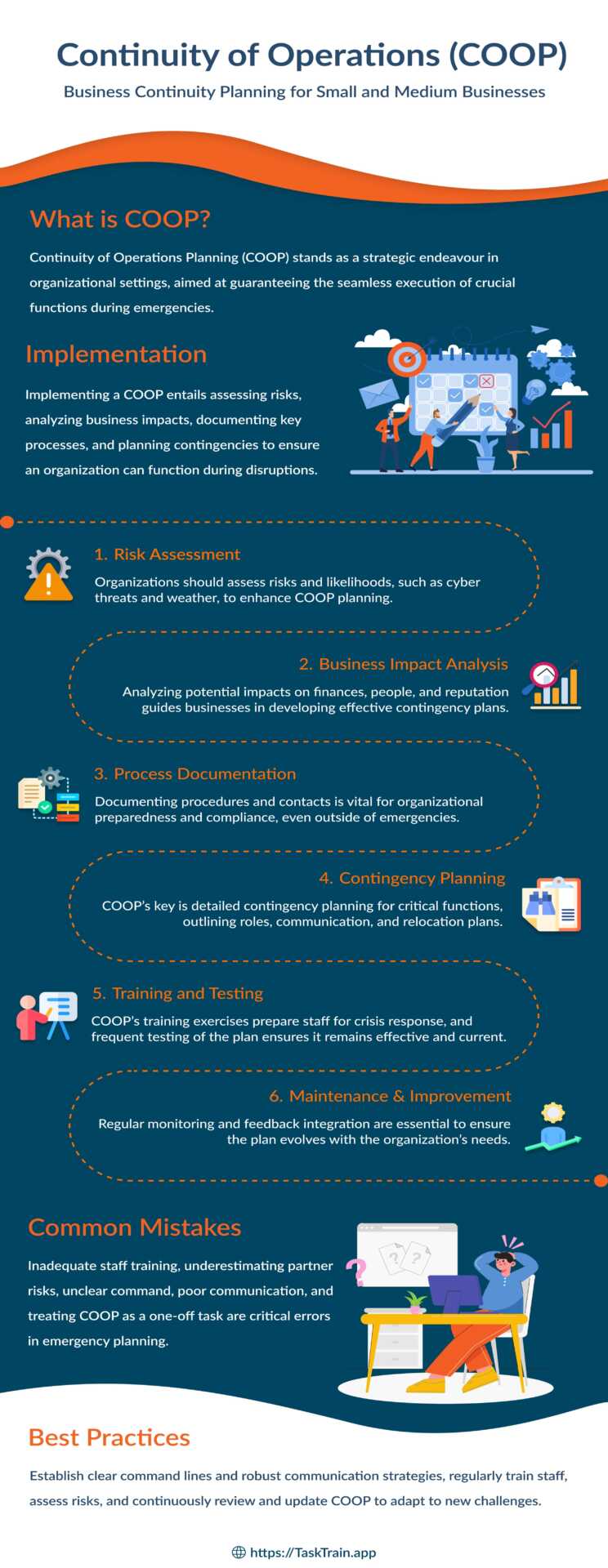Continuity of Operations Planning (COOP) stands as a strategic endeavor in organizational settings, aimed at guaranteeing the seamless execution of crucial functions during emergencies. This proactive initiative spans a spectrum of threats, including natural disasters, technological disruptions, and national security emergencies, ensuring the sustained functionality of governments, departments, businesses, and agencies by relocating operations to alternate sites when necessary.
Challenges Happen Frequently!
Before delving into the intricacies of Business Continuity Planning (COOP), it’s crucial to understand the prevalence and impact of disruptions. Shockingly, 43% of companies lack a COOP, and 51% of businesses experiencing significant natural disasters close within two years. This emphasizes the urgent need for comprehensive COOP strategies.
According to statistics:
| Statistic | Percentage/Number |
| Companies without a COOP | 43% |
| Businesses closing after significant natural disasters | 51% |
| Small businesses without a Disaster Recovery Plan | 75% |
| Companies maintaining 100% operations during IT outage | 35% |
| Organizations consider cyber attacks the most disruptive | 52% |
| Businesses without a COOP never recover after a disaster | 50% |
Implementation Of COOP
Risk Assessment
Before using COOP, organizations need to look at possible problems, see how bad they could be, and figure out how likely they are to happen. This includes things like cyberattacks or bad weather. Doing this helps a lot in the planning process.
Business Impact Analysis
It’s really important to know how things going wrong will affect a business. This analysis looks at how much money might be lost, how many people might be affected, and how the business’s reputation could be hurt. This information is used to create good backup plans.
Process Documentation
Writing down important things, like how to do certain tasks and who to contact, is crucial. Even when there’s no crisis, having this information helps the organization be ready. It’s also important to follow the rules.
Contingency Planning
Making detailed backup plans for each important task is the most important part of COOP. These plans should include when to start them, who does what, how to communicate, and where to go if the usual place isn’t safe. Having these plans makes it easier to respond quickly when there’s a problem.
Training & Testing
Training Exercises
Making sure everyone knows what to do during a crisis is really important. Regular practice helps people get used to their roles and creates a culture of being ready for anything.
Business Continuity Testing
Testing the COOP plan a lot, in different ways, helps to find out what’s working well and what needs improvement. Doing this often, whether planned or not, is important to keep the plan up to date.
Maintenance & Improvement
Plan Monitoring
COOP is not something you just write down and forget. It changes and evolves. Regularly checking how things are going, seeing if the plan is working, and getting feedback from people involved helps to keep it useful.
Plan Revision
Feedback from testing and monitoring is used to make the plan better. It’s important to learn from mistakes and make changes based on what’s happening in the organization.
- Set Up a Dedicated COOP Team:
It’s a good idea to have a specific group or person in charge of the COOP program. This helps make sure that someone is responsible for it and knows what to do. This brings clarity and accountability to the plan.
- Use Business Continuity Management Software:
Make things easier by using special computer programs for COOP. These tools help make processes smoother, improve the accuracy of analyzing business impacts, and make planning more efficient.
- Regularly Check and Update Plans:
Don’t let your COOP plans get old and dusty. It’s important to regularly look at them and make changes to match how the business is doing. This way, the plans always fit the current situation.
- Encourage a Prepared Culture:
Make sure everyone in the organization knows how to handle problems. Promote a culture where being ready for anything is important. This way, everyone understands their roles when things go wrong.
- Work Together with Others Outside:
Create ways to talk and work with people and groups outside your organization. This helps build a network that can respond well to problems. Collaboration with external partners is key to an effective response.
Common Mistakes to Avoid in Continuity of Operations Planning (COOP)
- Forget to Train Staff Well:
A big mistake is not teaching everyone in the company what to do in an emergency. Sadly, many companies forget this important step, and it can cause problems when things go wrong.
- Underestimate Risks from Partners:
It’s a big worry when companies don’t realize how much risk comes from working with others (like vendors). Ignoring or not understanding these risks can cause serious problems.
- Don’t Set Up a Clear Chain of Command:
If it’s not clear who is in charge during an emergency, there can be a lot of confusion and delays in fixing the problem. Having a clear plan of who’s in charge is really important.
- Forget to Make Good Communication Plans:
If there’s no clear way for people to talk to each other during a problem, it can make things worse. Setting up good and efficient ways to communicate is crucial.
- Think COOP is a One-Time Thing:
Some businesses make the mistake of thinking they only need to plan once. But actually, it’s important to keep improving the plan. This ongoing improvement is key to making sure the plan is strong and can handle new problems that might come up.
Conclusion
In an era where downtime is unacceptable, small and medium businesses must prioritize Continuity of Operations Planning. The statistics speak for themselves, emphasizing the financial and operational risks associated with the absence of a robust COOP. By following best practices, avoiding common mistakes, and implementing a comprehensive and evolving plan, businesses can ensure resilience in the face of unforeseen disruptions.
Recent Posts
How Small Businesses Can Use Business Process Management Software?
Introduction Imagine a tool that transforms chaos into order, a magic wand for your small business's processes. That's Business Process [...]
Continuity of Operations: Business Continuity Planning for Small and Medium Businesses
Continuity of Operations Planning (COOP) stands as a strategic endeavor in organizational settings, aimed at guaranteeing the seamless execution of [...]
Common Mistakes to Avoid When Developing Standard Operating Procedures
Introduction Standard Operating Procedures (SOPs) are internal company documents that outline instructions for employees to carry out various tasks [...]





 .
.